This morning was my first breakfast at the VOCO. It was really great! A special “barista,” everything from hot food to small pastries to fruit to (YUM!) local ancient grain and sourdough bread (they even have my secret passion – Vegemite)! The hotel is well located, though in the middle of a very steep hill! So you have a hike like the beginning of River Oaks Road back home to get either back to the hotel, or from the hotel, to anywhere else. My foot is doing okay – I am using KT tape under my sock plus my brace. The 30 minute hike in LAX absolutely did it no good, but I used the “nubbly” Lacrosse ball to try to move my arch up and bones back together – so far, so good.
Our group couldn’t be nicer. As my Mom would say, no “Poops.” I’m the youngest, with the oldest being in their mid-80s. With my foot, everyone is spryer than I am! There are 16 of us, 5 guys (2 Jims, David, Mark, Don), and 11 women – Jim is with Marilyn, David is with Elizabeth, Jim 2 is with Bev, Mark is with Elizabeth (who goes by “Betsy”), then singles are Cindy, another Marilyn, Lynn, Toshiko, Jan, Pam, me, and Don (he is a widower, but he and his wife used to travel with Jim and Marilyn so they’re an “OAT pod” doing their travels together).
Today was Waiheke Island. “Long Sheltering Island” in Maori – “Winery Island” to the tourists! There are 30 wineries, 18 winery “venues” for events, craft beers, a gin distillery, and an award-winning whisky. It’s the third most populous island in New Zealand (after North and South Island) but the most densely populated, and the second largest island in the Hauraki Gulf of New Zealand. It has 9,400 permanent residents and boasts over 1,000 hours more of sunshine than other parts of Auckland (as well as a slightly warmer overall climate and over 40 kilometers of beaches), so it’s definitely an “island paradise.”
I’ll skip the basics – how long/wide the island is, etc. – but if you click on the words above, it will take you to Wikipedia. I guess I’d say that (while far smaller), Waiheki is a bit like Sedona. It started out as a hippie artist’s colony, and now is a “mix” of artists . . . and millionaires, with over 3,000 holiday homes on the coast. It’s one of the most desirable “suburbs” of Auckland and is a thriving arts, theatre, music, and cultural venue reachable by about a half hour ferry ride. There are no hotels or high rises on the island, so their version of “Air B&B” does a booming business, especially for weddings. New Zealand was the first country to give women suffrage, and they added same-sex marriage in 2012.
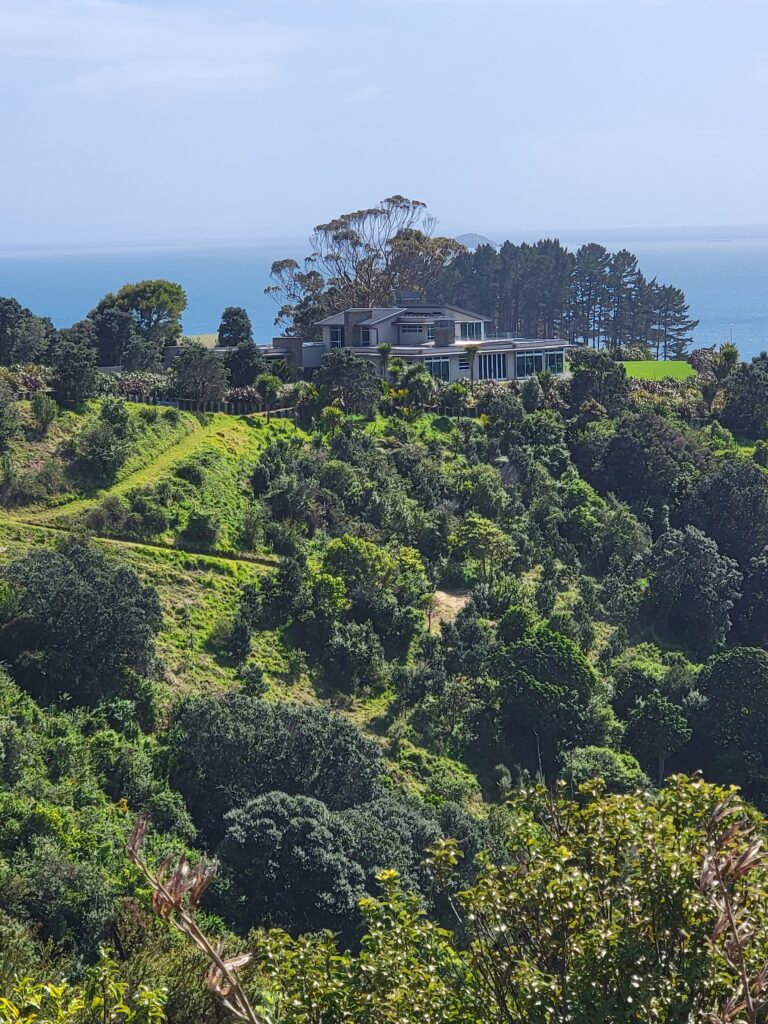
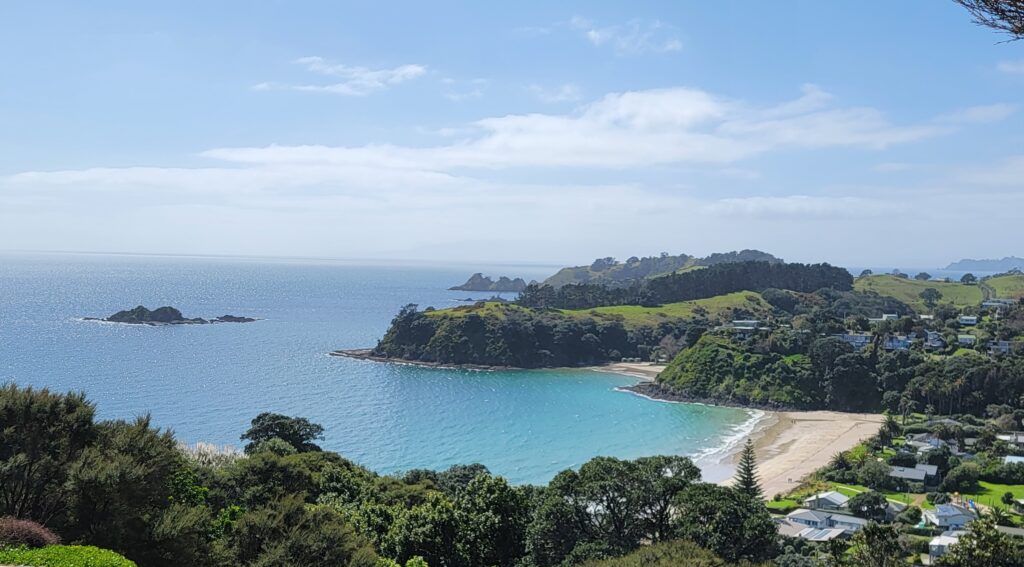

For $1 million NZ, you can get a shack or bare land with no view – to get sea view, you’re looking at up to $40 million. Above is a photo of a $14 million dollar “holiday home” looking down on Palm Beach. The house is empty 46 weeks of the year (!)
We had a stop in the main town, Oneroa, and a shop reached out and grabbed me, spitting me out with a merino wool Dolman-sleeved zip-up sweater (with pockets!) and a local artist’s earrings and a necklace that represents Māori New Year. It was not an inexpensive purchase, but the U.S. dollar is strong, and all were exceptional pieces.
We had learned about Māori New Year from Dane yesterday – a constellation that looks exactly like the Pleiades back home (upside-down “P”) comes into the sky. Each star represents where one can get food – salt water, fresh water, land, air, etc. The star that is shining brightest that year represents what will be abundant.
I’ve been wearing the “greenstone” (jade) necklace that my parents brought me back from NZ many moons ago, which everyone is commenting on. :-) But now I’m wearing my new Waiheke Island necklace representing Māori New Year, with the Pleiades on the top in raised silver, over a land/sea hammered area with a dark sapphire representing the moon.
Our driver/guide Neil is ex-pat British who now lives full time on the island. He was funny – said that many Argentinians had moved to the island, had added a great vibe … and also were “ringers” on their soccer team until the rest of New Zealand wised up 😊
Water is a bit of a problem in the island – it’s mainly rain collected on roofs and stored in big tanks. Water “bores” (wells) are few and far between. If you run out, it costs $300NZ to half fill a tank, which lasts a couple months. Everyone is on a septic system which is based on bedrooms – so there are a lot of HUGE “two bedroom” houses, so that they can stay within the confines of the septic on their property. The wineries have no irrigation, but this makes the vines dig deep (our guide said: “To panic the vines”), which as I know from my Master Sommelier course makes better wine. Syrah is the most predominant because of the Bordeaux-like land, and Waiheke winegrowers won best Syrah in the world in 2009. But it runs the gamut – there is even Batch Winery at the very top of the highest hill, which makes a Prosecco style wine in tanks that they imported from Italy.
As you can imagine, petrol on the island is at a premium, at about $1/liter higher than the mainland. There is a lot of intra-island swapping of things, to try to keep importing to a minimum. Electric cars/motorbikes are making big inroads. Our guide commented that while the “Leaf” car doesn’t have a lot of distance on a charge and therefore isn’t as big on the mainland, its “about 50k distance on a charge” is plenty for the island! The roads wind and are very steep in spots – didn’t see anything like golf carts for example, because I don’t think they could power up the “ups.”

cork tree at Casita Miro

cork tree close up
We headed to Casita Miro for a wine and tapas tasting. It’s the most unique winery on the island, started by Barnett (a doctor) and Kat (a lawyer). Now their son George is the winemaker as his dad is in his 70s, but Barnett still is the “artist in residence” for the artistic installations. They have four types of white wines (fermented in stainless steel) and reds fermented in French oak. While the “miro” is a native tree that feeds the native birds, Barnett has made a play on words, as the wall leading up to the winery reminds one of “Miro” the artist. The art “installations” were inspired by Barcelona.
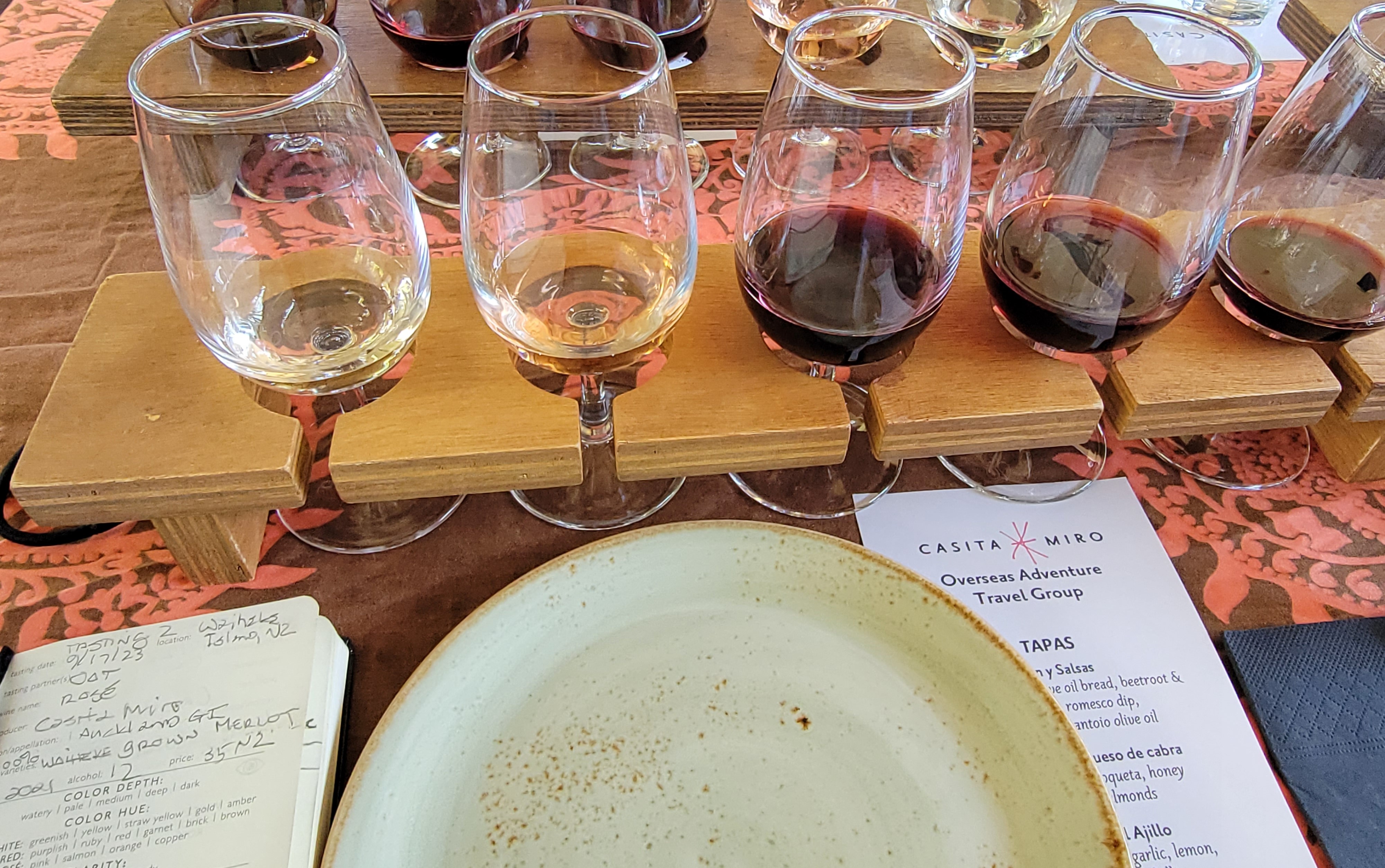

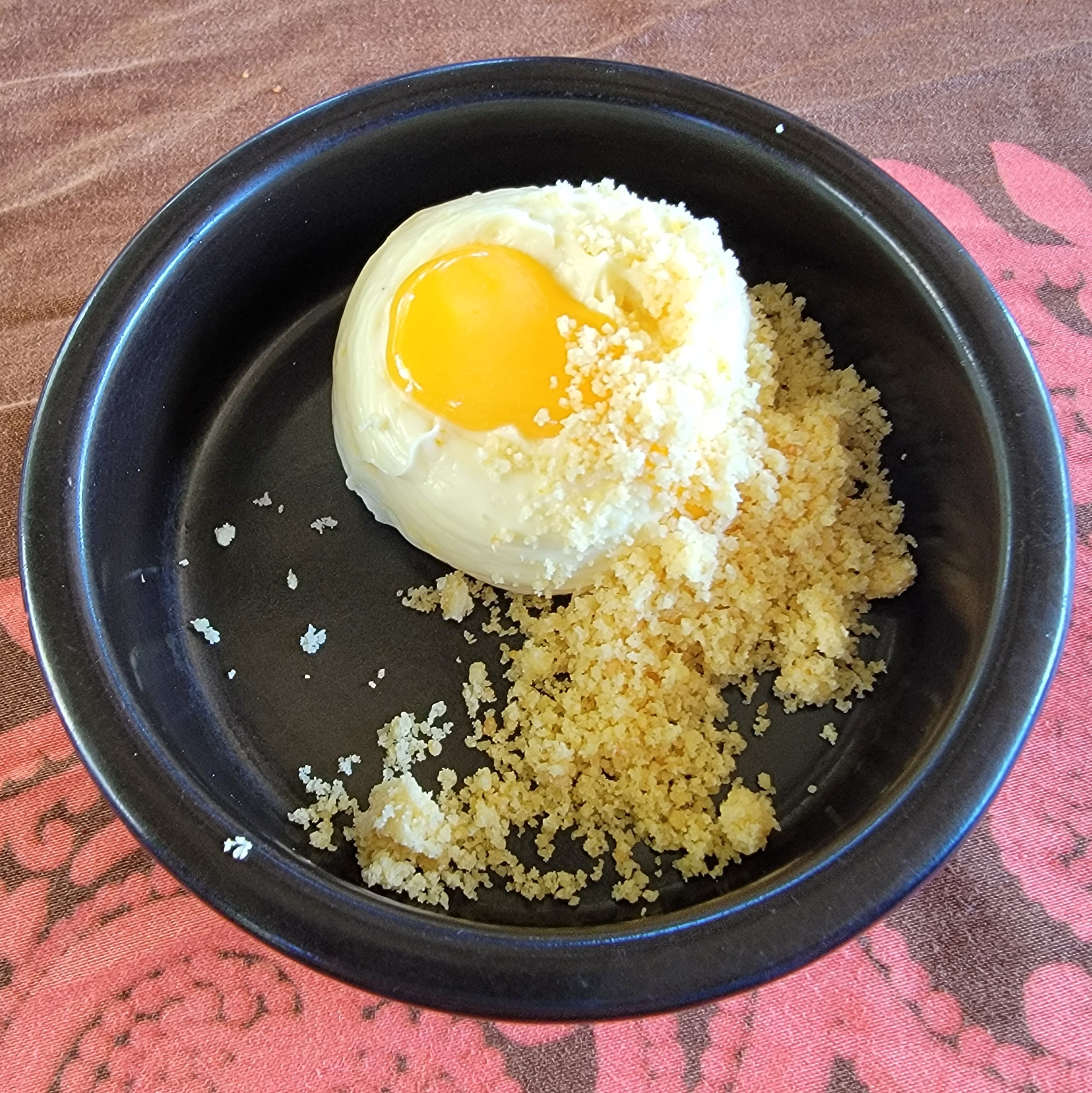
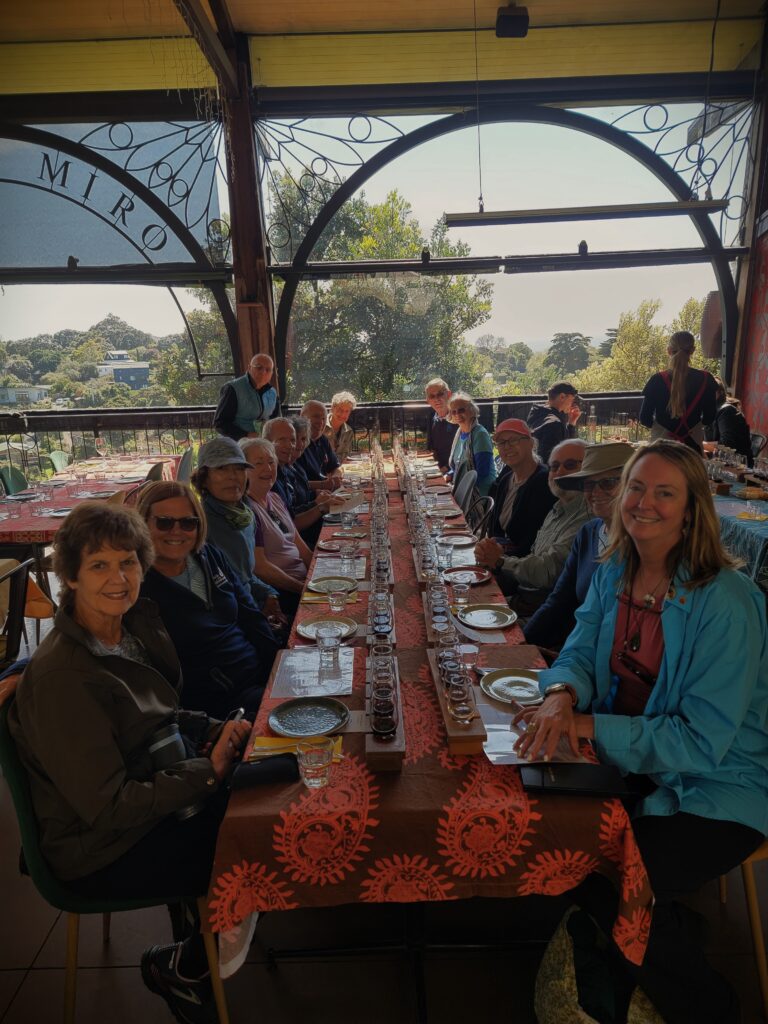
I had fun practicing my wine tasting, but their wines weren’t a huge hit. I did have fun though with the Marilyn that was sitting across from me, explaining how she could take some of the tapas and change the flavor profile of the wine. She particularly disliked the fortified red “Madame Rouge,” but I told her to take a piece of chocolate out of her purse, let that melt in her mouth, then try the wine. Et voila! Madame Rouge was my favorite actually – it is made solera style and reminded me a bit of madeira.
Below you can see some of the photos of the art that the owner made.
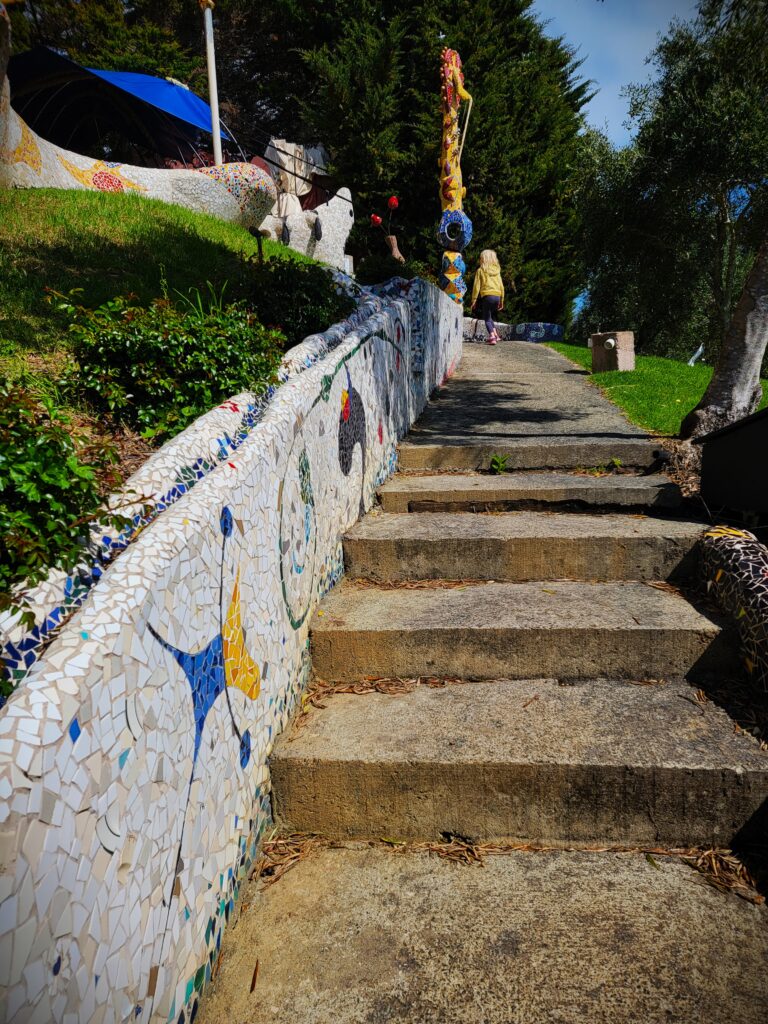
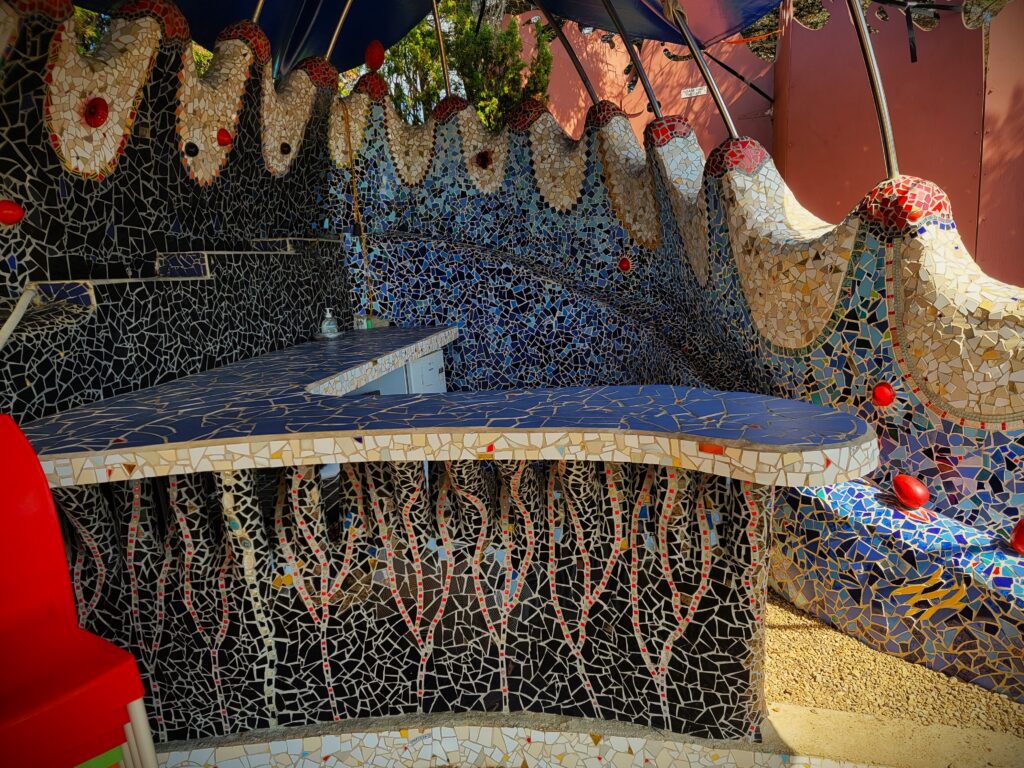
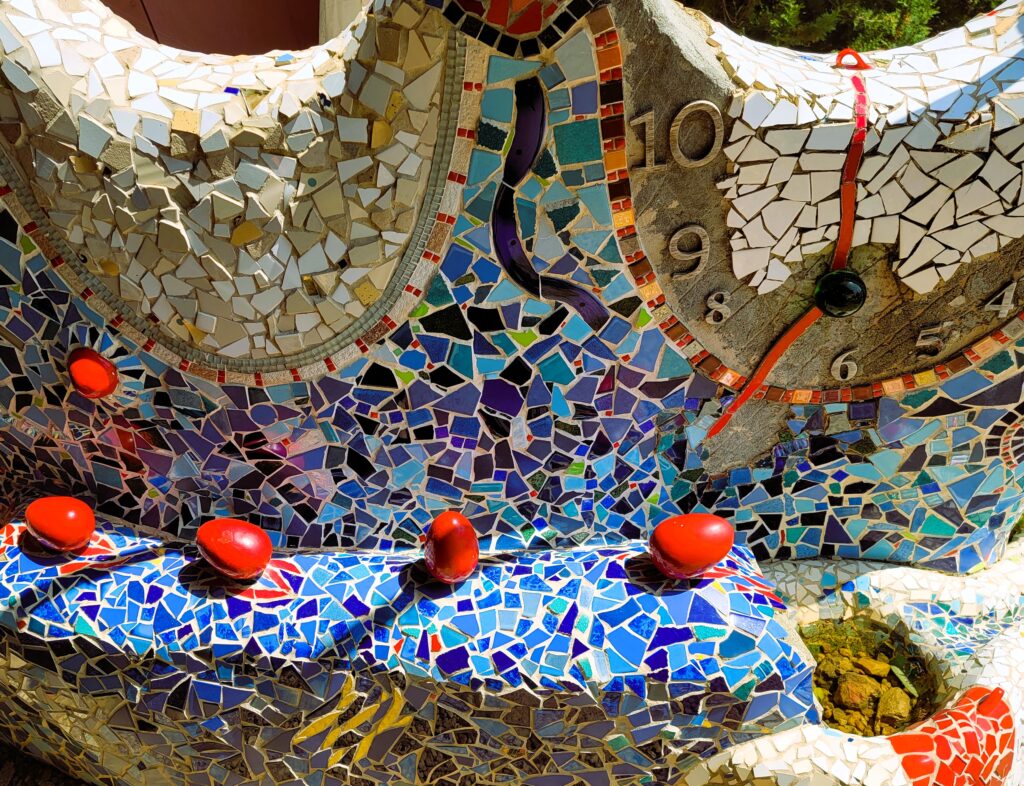


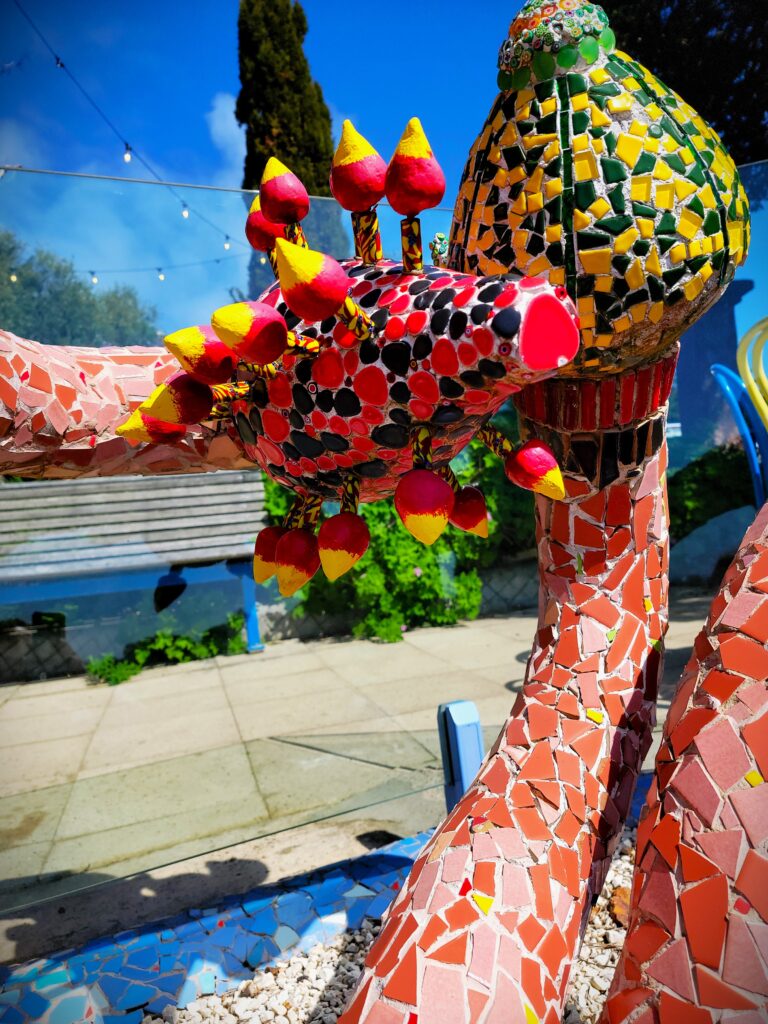


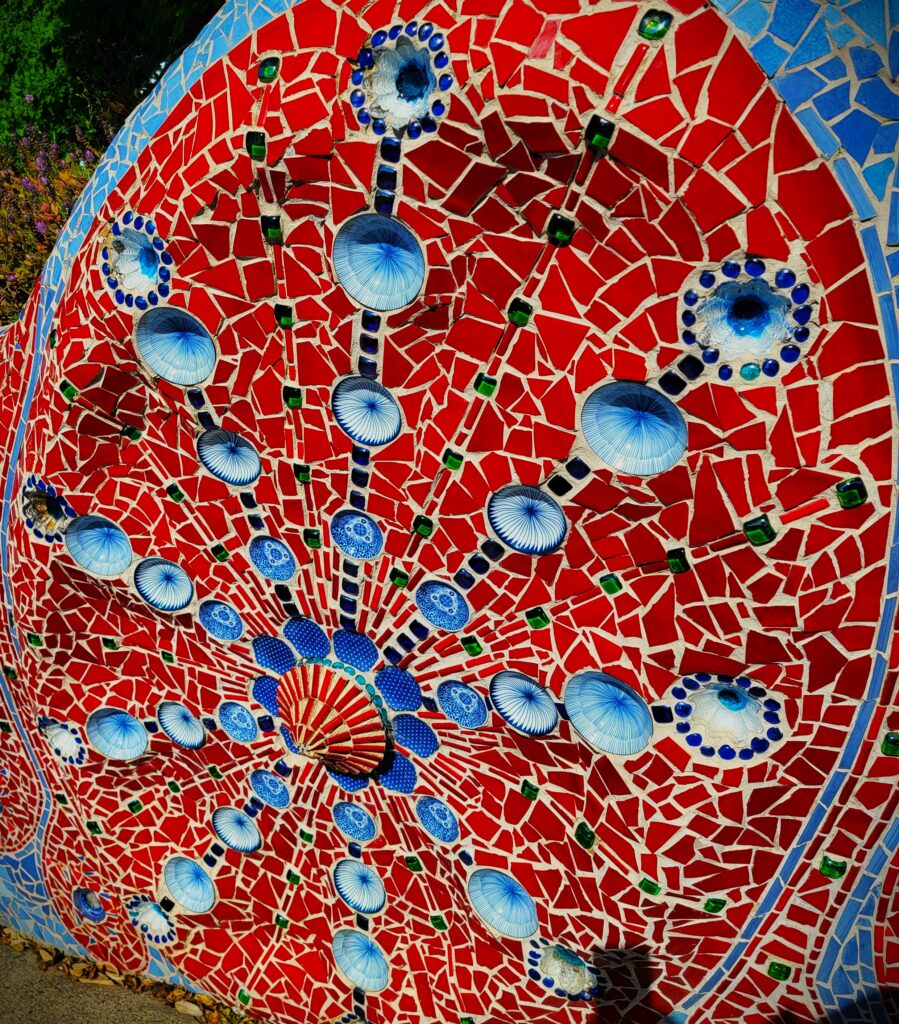
And below, here is my first placement of an H “cremarble.” I had SuperGlue in my purse (Be Prepared…) and so I carefully placed the marble onto this sculpture. I wonder if the artist will notice it. Well . . . it’s stuck there now! I thought it was the perfect spot for it. What do you think?

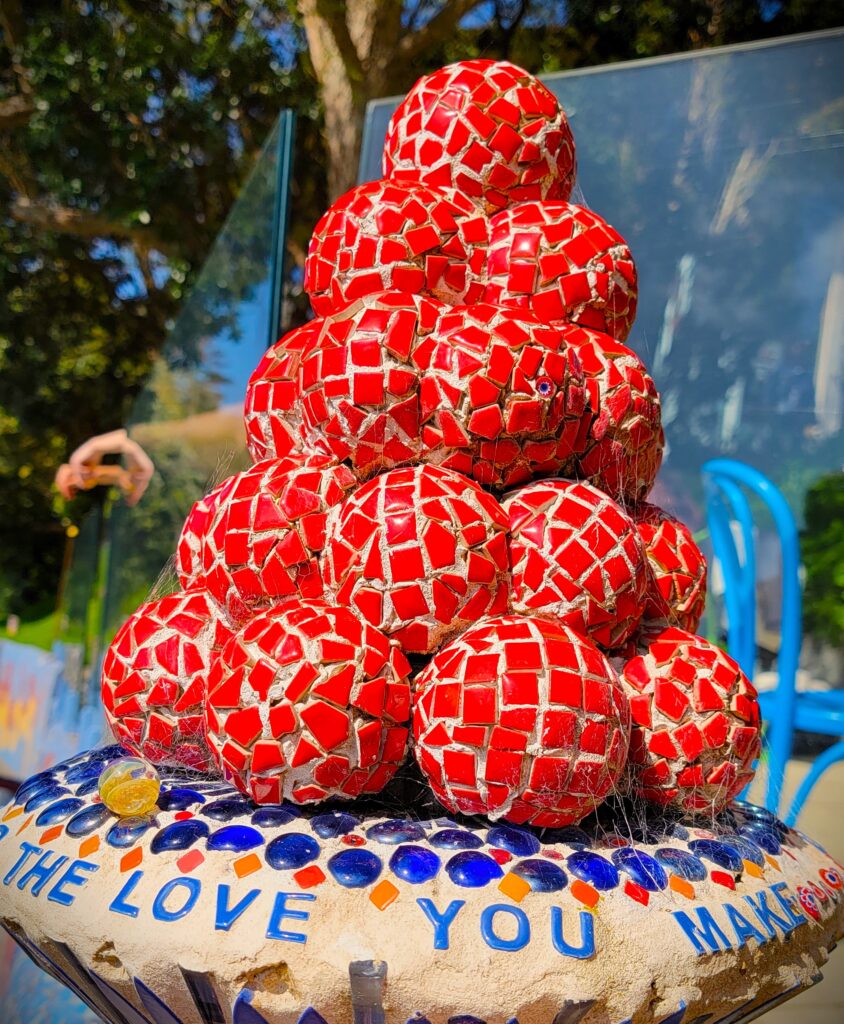
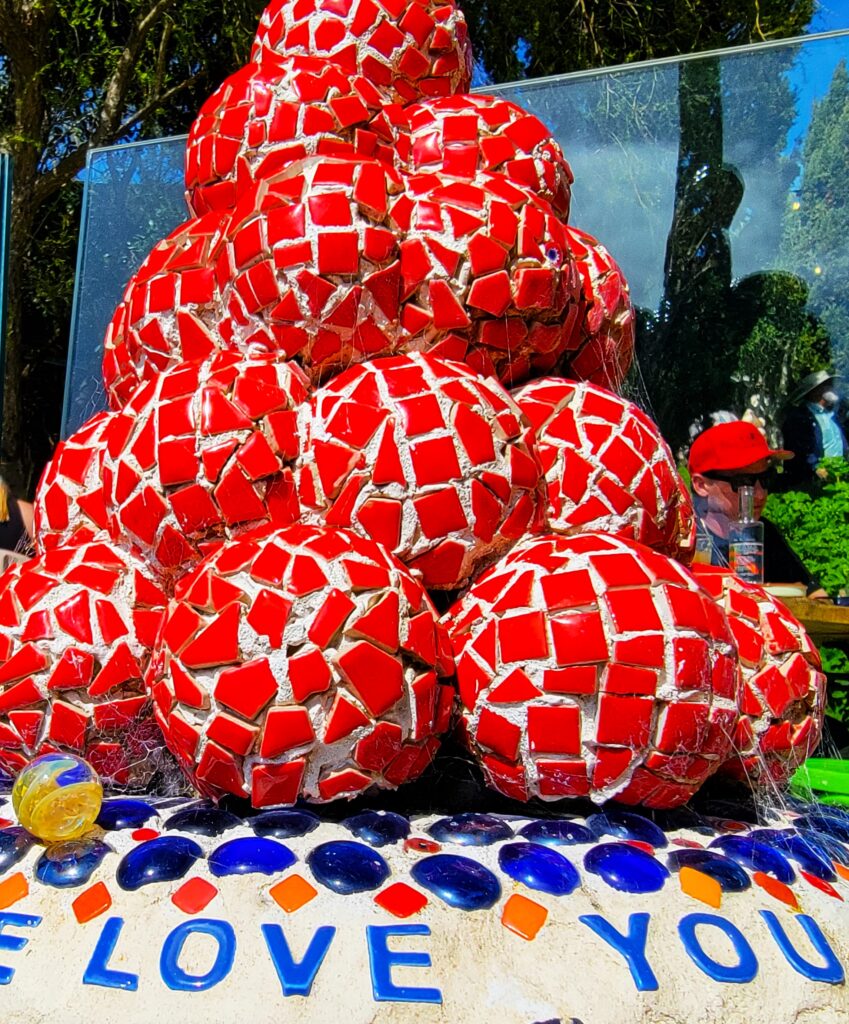

Off to olive oil tasting!
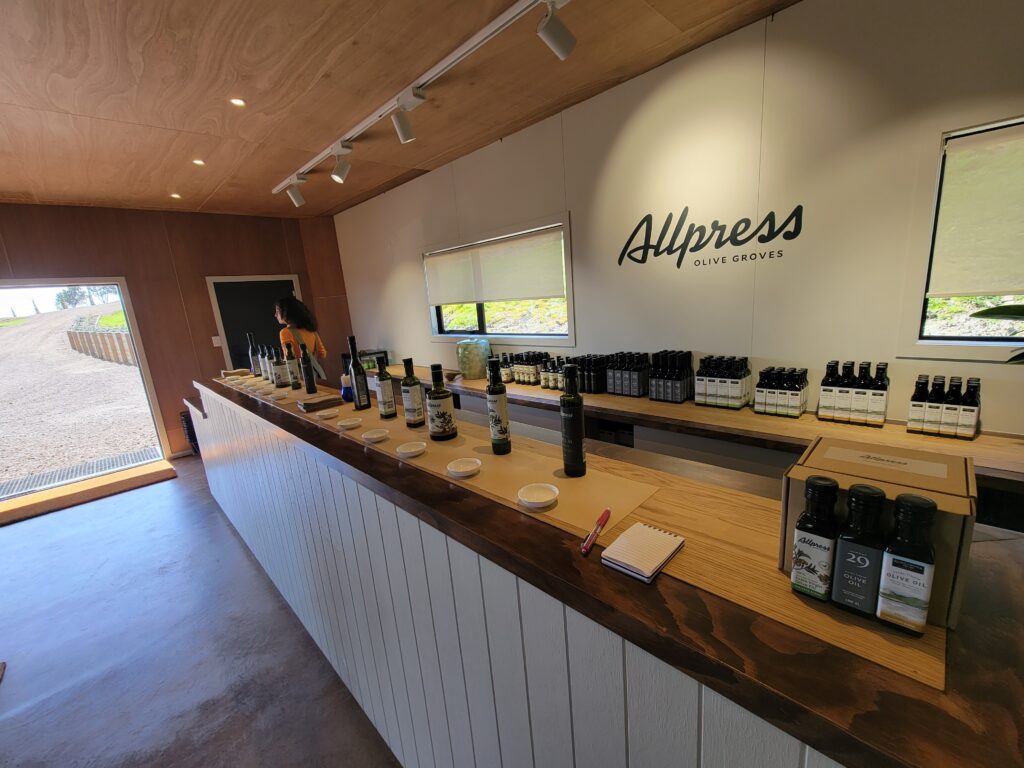
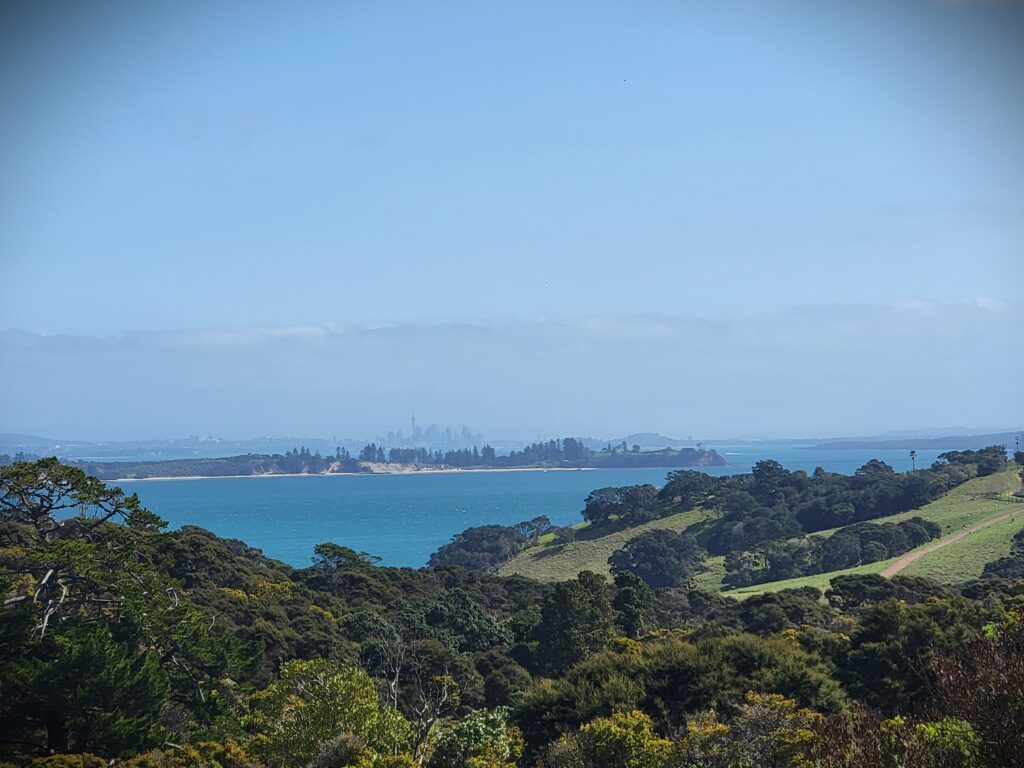

Allpress has 10 varieties of olives: French, Spanish, Italian, Greek, plus, about 200 years ago, a missionary planted olives here, which have the creative name of J-1, J-2. Etc. (Called the “J” varieties), which have a distinctive nutty flavor. The green olives have increased polyphenols and a peppery “bite” – the black olives make more, fruitier, oil.
We got to see a video of how they collect the olives – silk parachutes are laid under the trees to catch the olives, which are “raked” off with electric rakes. It takes 4-6 people about 10 minutes to clear a tree. 7 kilograms of fruit makes 1 liter of oil; Allpress made 6,000 liters this year.
The fruit is then taken to a centrifugal (not “crush”) mill, which gives better control of the oil and its byproducts. The “fruit paste” of the olive/stone mash is made into compost, the “fruit water” is used for irrigation, and then the oil is, of course, oil 😊 The entire fruit is crushed (including the stone), which actually has tannins that help bond the oil together. No pesticides are used on the island because the ocean air keeps the bugs away.
Apparently, the mill (which is at a different spot on the island) smells like fresh mown grass when the oil is being extracted. The Allpress gal said, “If Green were a smell, that would be it.” The very first press of the season is unfiltered and goes rancid in about three months – but is highly prized and basically just the locals get it.
We tried six different oils, from a very crisp lively herbaceous one to a bold nutty peppery one (that had an intense “leafy” scent). You could pick and choose to buy three small bottles from five of the oils (one, called “Waiheke ‘22” is only sold in bigger bottles – it’s a mélange of all the oils from 2022, which was a great year). Lynn bought three of the last oil (the intense one), I bought three different ones to bring to my folks, as my Mom loves to use EVO. (Hi Mom, I know you’re reading this blog to Dad, pretend you didn’t read that!)
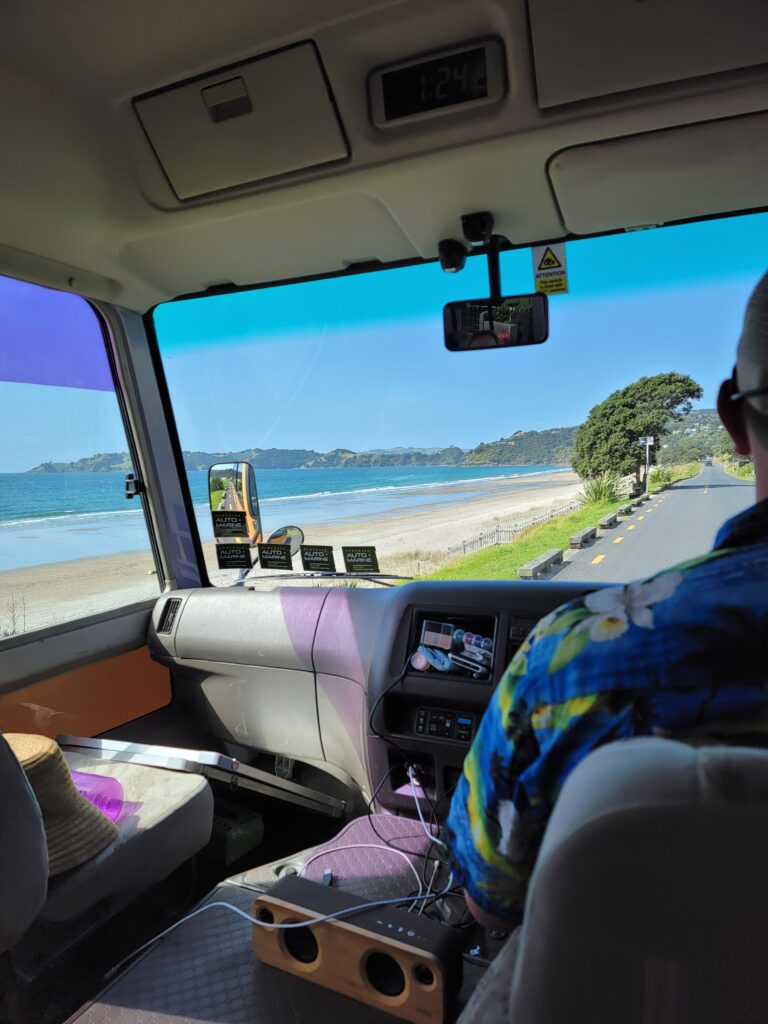
The photo to the right is Onatongi Beach, which is a mile long and gorgeous. But, back to olives. Most wineries and even private persons have olive trees. Allpress, where we had our olive oil tasting, allows any islander to come “mill your own vintage” from their olives. Because of the hot/dry summers and the very small time between pick and press, the olive oil is a spectacular quality, and wins many, many awards, even against Italian olive oil, at Italian competitions! Olives don’t like land that holds water – if there is too much rain or the land holds the water, there is too much water in the fruit.
We took the ferry back to Auckland and got an hour to rest, then the bulk of us met Rod at a local Belgian pub that specialized in green-lipped mussels, which are grown on the far side of Waiheke Island. I had the best beer I’ve ever had – perfect flavor profile for me. (I’m not an ale person.) The beer portion of the Master Sommelier training really helped me to consider why I might not love beer – turns out that I don’t like ales, but pilsners are great! (top-fermenting versus bottom-fermenting yeast.)
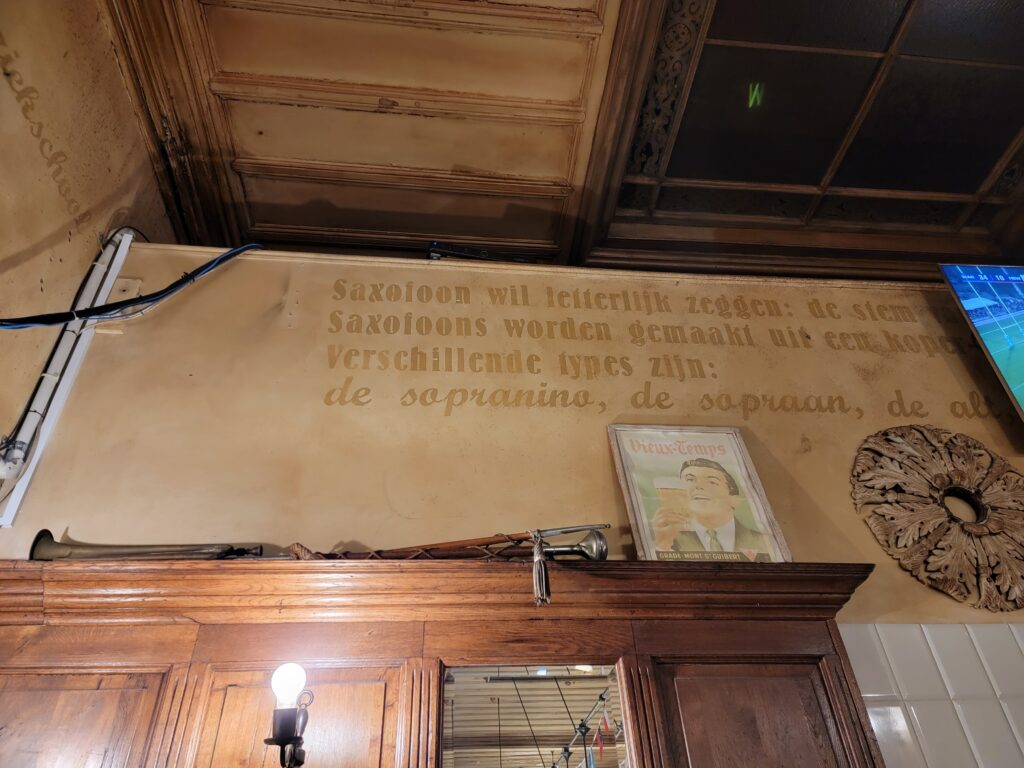


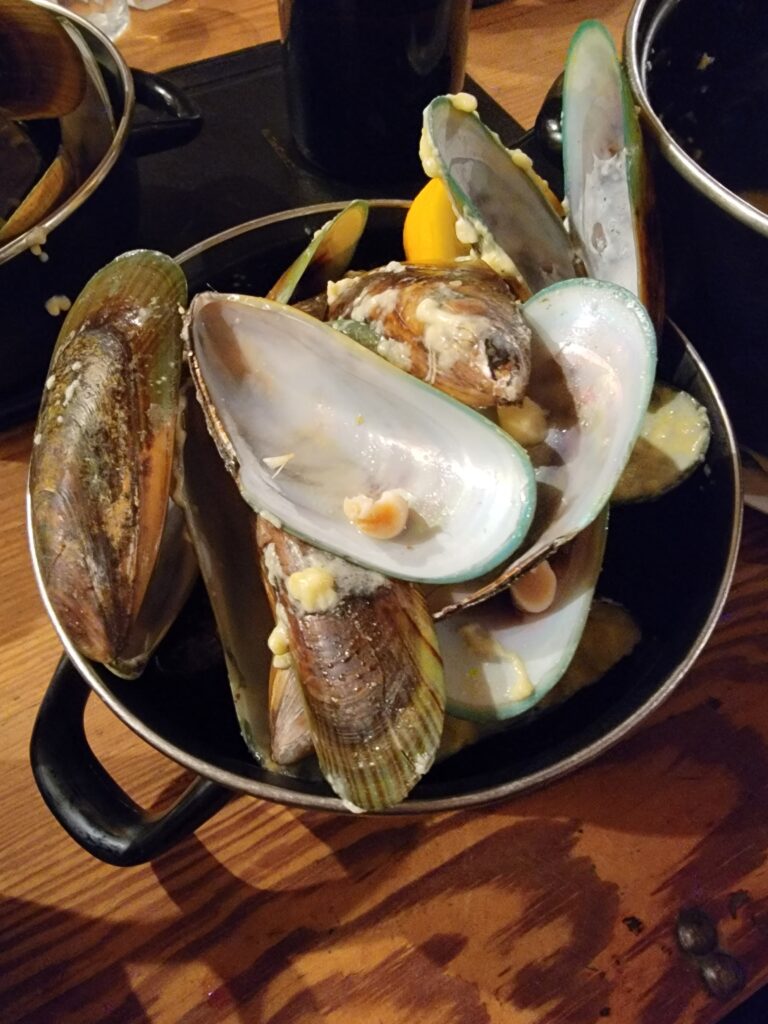

We toddled back to the hotel and were lights out by 9 – though back up at 4 (“rowing time”?) I am typing this after taking a shower and packing, though time to get dressed and out! Tomorrow is a well-known gardens and a kiwi bird hatchery, on the way to Rotorua.
If you want $100 off, call OAT at 1-800-955-1925 and request a catalog, tell them you were referred by Sandy Shepard, customer number 3087257, and get $100 off your first trip!
